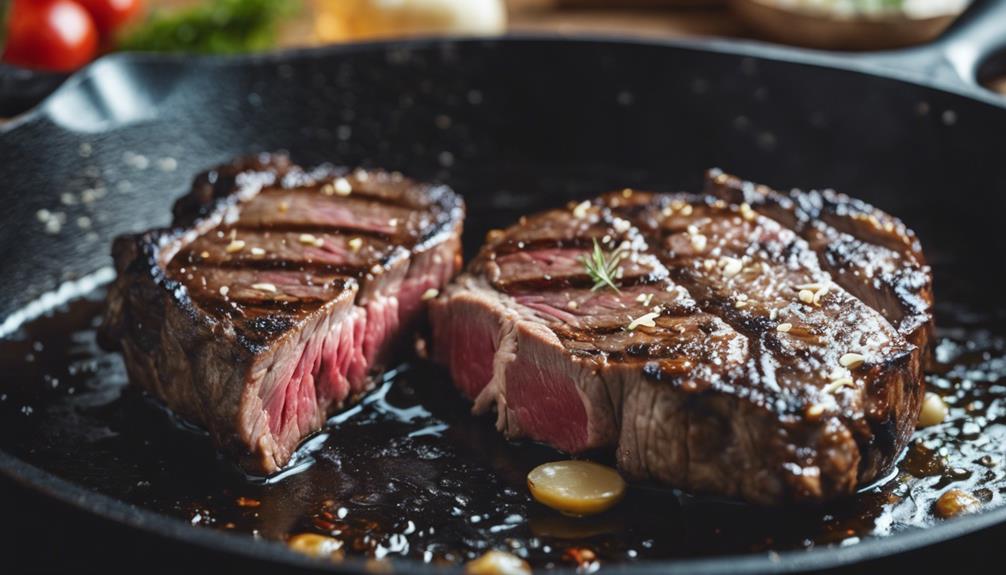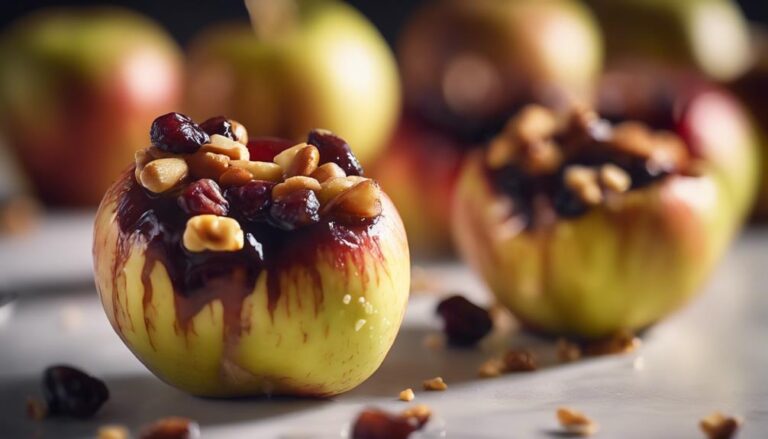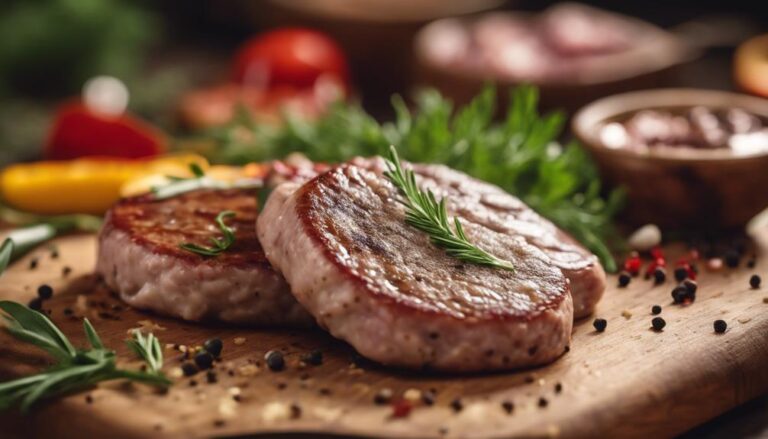Sous Vide Ribeye Steak With Garlic Butter
Elevate your dining experience by preparing sous vide ribeye steak with a luxurious garlic butter infusion. Begin by sealing the high-quality meat with aromatic herbs and seasonings, enhancing its rich flavors. Allow the precision of sous vide cooking to deliver tender, mouthwatering results. Finish by searing the steak to perfection in a smoking hot skillet or on the grill for a delectable crust. The marriage of sous vide cooking and garlic butter will create a symphony of flavors that will tantalize your taste buds. Get ready to savor an unforgettable culinary delight that will leave you craving for more.
What You Will Learn Here
- Sous vide ribeye ensures perfect doneness.
- Garlic butter enhances richness and flavor.
- Searing after sous vide for texture.
- Infuse ribeye with herbs for depth.
- Presentation with roasted veggies elevates dish.
Sous Vide Cooking Origins
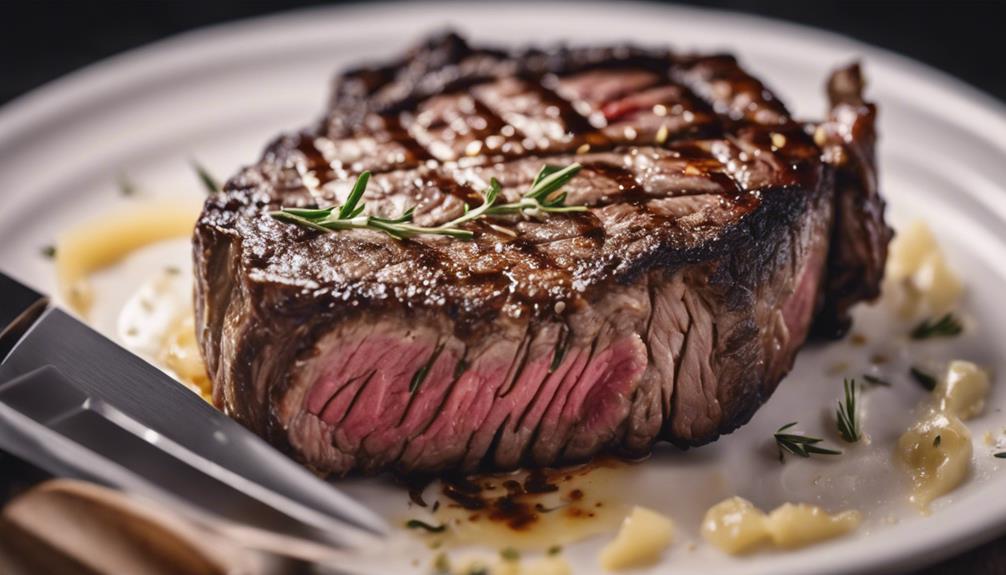
Let's trace the roots of sous vide cooking, a technique with a fascinating history. Originating in France, sous vide has evolved from its early days in the culinary world to become a modern cooking method embraced by chefs worldwide.
Understanding the traditional and contemporary approaches to sous vide can enhance your appreciation for this precise and innovative cooking technique.
History of Sous Vide
Tracing back to the late 1960s, the origins of sous vide cooking can be linked to the innovative work of French and American chefs seeking to revolutionize culinary techniques.
Evolution in cooking methods and technological advancements played an essential role in shaping the sous vide cooking we're familiar with today.
Initially developed as a way to preserve food, the sous vide technique has evolved into a popular method known for its ability to enhance flavors and textures through precise temperature control.
This cooking method has transformed the culinary landscape, allowing chefs and home cooks alike to achieve consistent, restaurant-quality results.
The history of sous vide showcases how a blend of creativity and technology can lead to significant advancements in the culinary world.
French Culinary Technique
The roots of the modern sous vide culinary technique can be traced back to the innovative practices of French and American chefs in the late 1960s.
French cuisine, renowned for its emphasis on precision cooking, played a significant role in shaping the sous vide method. This technique, which translates to 'under vacuum,' involves vacuum-sealing food in a bag and cooking it in a precisely controlled water bath at low temperatures. French chefs initially used this method to maintain the integrity of delicate ingredients, resulting in remarkably tender and flavorful dishes.
The marriage of French culinary expertise with American ingenuity led to the development of sous vide cooking as it's practiced today, revolutionizing the way chefs approach cooking with unparalleled precision.
Modern Sous Vide Methods
Modern sous vide methods revolutionized the culinary world by introducing a precise and controlled cooking technique that has its origins in the innovative practices of French and American chefs in the late 1960s.
Sous vide equipment plays an important role in this method, with immersion circulators and vacuum sealers being essential tools for achieving consistent and perfectly cooked dishes. Whether you're preparing delicate fish, tender meats, or vibrant vegetables, sous vide recipes benefit from the precise temperature control these devices offer.
The sous vide cooking process involves sealing ingredients in a bag, submerging them in a water bath set to a specific temperature, and allowing them to cook slowly and evenly. This method has gained popularity for its ability to produce restaurant-quality meals with minimal effort.
Key Ingredients for Sous Vide
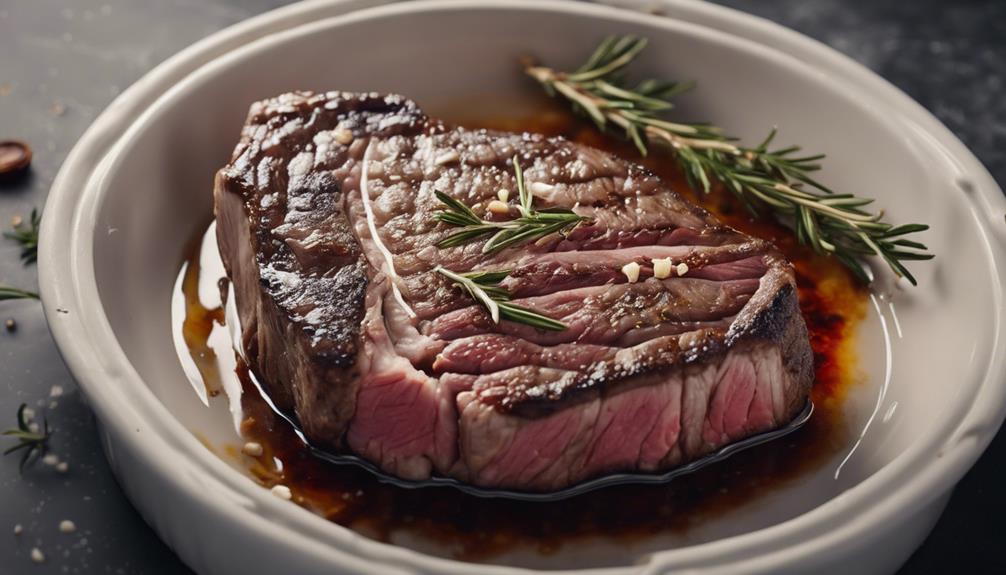
To achieve perfect results when cooking sous vide, selecting the right ingredients is essential for enhancing the flavor and texture of your dish. When it comes to sous vide cooking, precision is key, starting from the equipment you use to the control of the temperature throughout the cooking process.
Here are three key ingredients to take into account for your sous vide cooking:
- High-Quality Meat: Choose cuts of meat that are well-marbled and of good quality. The controlled cooking environment of sous vide helps to tenderize tougher cuts, but starting with a high-quality piece will elevate your dish to the next level.
- Fresh Herbs and Aromatics: Infusing your sous vide bags with fresh herbs like rosemary, thyme, or aromatics like garlic and shallots can add layers of flavor to your dish as it cooks.
- Quality Oils and Seasonings: Using high-quality oils like olive oil and flavorful seasonings like sea salt and freshly ground pepper can enhance the taste of your sous vide creation.
Succulent Sous Vide Pork Belly
When it comes to sous vide cooking, you can't go wrong with the succulent sous vide pork belly.
Imagine perfectly seared scallops, a tender sous vide lobster tail, and mouthwatering sous vide chicken thighs – these are just a few of the delicious points to explore.
Let's elevate your culinary skills and savor the exquisite flavors that sous vide cooking has to offer.
Perfectly Seared Scallops Recipe
For an exquisite culinary experience that tantalizes the taste buds, consider trying out this Perfectly Seared Scallops Recipe featuring Succulent Sous Vide Pork Belly. When aiming for Scallops perfection, the key lies in achieving a golden sear while maintaining a tender interior. Here are some essential tips to elevate your dish:
- Quality Scallops: Start with fresh, high-quality scallops for the best flavor and texture.
- Proper Searing Technique: Make sure your pan is hot before adding the scallops to achieve a beautiful caramelization.
- Balanced Flavors: Pair the succulent Sous Vide Pork Belly with the scallops to create a harmonious blend of Buttery goodness and savory flavors.
Sous Vide Lobster Tail
Discover the rich, succulent flavors of Sous Vide Lobster Tail paired with the indulgent taste of Succulent Sous Vide Pork Belly for a culinary experience like no other. When preparing this exquisite meal, make sure you enhance the lobster tail pairing with the perfect Sous Vide lobster seasoning to elevate its natural taste.
Here are some essential tips to make your Sous Vide Lobster Tail truly unforgettable:
- Select Fresh Ingredients: Choose high-quality lobster tails and seasonings for the best results.
- Precise Temperature Control: Maintain the water bath at the ideal temperature for perfectly cooked lobster.
- Finishing Touch: Consider searing the lobster briefly after sous vide for a delightful texture and appearance.
Enjoy the harmonious blend of flavors and textures in this exquisite dish.
Delicious Sous Vide Chicken Thighs
Sink your teeth into the succulent perfection of Sous Vide Chicken Thighs, a delectable dish that pairs effortlessly with Succulent Sous Vide Pork Belly. Juicy chicken thighs are transformed into tender bites of flavor when cooked sous vide style. Enhance the taste by experimenting with flavorful marinades to create a dish that will tantalize your taste buds.
Here are some tips to elevate your Sous Vide Chicken Thighs experience:
- Season generously before vacuum sealing to infuse flavors.
- Experiment with different herbs and spices to create unique taste profiles.
- Finish by searing the chicken thighs for a crispy outer texture that complements the juicy interior.
Delight your guests with this exquisite dish that promises a burst of succulence in every bite.
Searing Sous Vide Steaks
When it comes to searing sous vide steaks, you'll discover the vital importance of this final step in enhancing flavor and texture.
Let's explore the best searing techniques and essential tips for achieving the perfect sear, such as ensuring your pan is smoking hot before adding the steak.
Understanding the ideal searing temperature and mastering these techniques will elevate your sous vide steak to a whole new level of culinary excellence.
Importance of Searing
To enhance the flavor and texture of your sous vide steaks, searing them after cooking is essential. Searing benefits the steak by creating a beautifully caramelized crust that adds depth and richness to the overall taste. This process also provides a pleasant textural contrast to the tender interior of the meat.
When considering searing techniques, timing is important. A hot pan or grill should be used to quickly sear the steak for a short period to avoid overcooking the already perfectly cooked center achieved through sous vide. The ideal searing time varies depending on the thickness of the steak, but a general rule is to sear each side for about 1-2 minutes to achieve a perfect crust without compromising the steak's juiciness.
Best Searing Techniques
For achieving the perfect sear on your sous vide steaks, employing the right techniques is essential. Here are some searing tips for flavor enhancement and presentation aesthetics.
To start, make sure your steak is thoroughly dried before searing; moisture inhibits the Maillard reaction important for that beautiful crust. Preheat your skillet or grill until smoking hot to achieve a quick sear without overcooking the meat. Use high smoke point oils like grapeseed or avocado for a crisp exterior.
Consider using searing tools like a cast-iron skillet for even heat distribution or a culinary torch for precise searing control. These techniques not only enhance flavor but also elevate the visual appeal of your dish, making it a feast for both the palate and the eyes.
Searing Temperature Tips
Achieving the perfect sear on your sous vide steaks requires precise control over the searing temperature. Searing techniques play an important role in flavor enhancement and texture development.
When searing sous vide steaks, it's vital to take into account the searing temperatures to guarantee a mouthwatering crust while maintaining a tender interior. For a delectable crust and best meat texture, preheat your pan or grill to a high temperature, around 400-450°F (204-232°C).
This high heat allows for a quick sear, locking in juices and flavors without overcooking the meat. Remember, a well-seared steak not only enhances the visual appeal but also provides a delightful contrast in texture that elevates the overall dining experience.
Final Thoughts
In conclusion, consider experimenting with various seasoning blends to elevate the flavors of your sous vide ribeye steak with garlic butter. Enhancing the taste of your dish can be achieved by exploring different flavor profiles that complement the richness of the ribeye. Whether you prefer a smoky paprika rub or a zesty herb-infused seasoning, the right blend can take your steak to the next level.
When it comes to finishing touches, a simple garnish of fresh herbs like parsley or chives can add a pop of color and freshness to your presentation. Remember, the first bite is with the eyes, so a well-plated dish can make a lasting impression on your guests. Additionally, consider serving your ribeye steak with garlic butter alongside roasted vegetables or a creamy mashed potato for a well-rounded meal.
Frequently Asked Questions
Can I Use a Regular Ziplock Bag for Sous Vide Cooking?
Yes, you can use regular ziplock bags for sous vide cooking, but it's recommended to use quality freezer bags for better results. If you have a vacuum sealer, that's ideal for sous vide, ensuring airtight seals.
How Do I Prevent My Sous Vide Steak From Being Overcooked?
To prevent overcooking your sous vide steak, guarantee precise temperature control, maintaining sous vide accuracy. Opt for proper sealing methods like vacuum sealers for airtight cooking. These steps will help you achieve perfectly cooked steak every time.
Is It Safe to Leave the Sous Vide Machine Unattended?
Leaving your sous vide machine unattended poses risks to food safety and kitchen safety. While technology offers convenience, always prioritize staying vigilant. It's essential to verify proper functioning and monitor your machine to prevent accidents.
Can I Reuse the Sous Vide Cooking Liquid?
When contemplating reusing sous vide cooking liquid, guarantee safety by following proper precautions. Reusing the liquid can enhance flavor infusion in subsequent dishes, but always prioritize hygiene and storage guidelines to avoid contamination risks.
How Can I Achieve a Perfect Medium-Rare Sous Vide Steak Every Time?
For a perfect medium-rare sous vide steak every time, maintain precise temperature control during cooking. After, use a high-heat searing technique to achieve a delicious crust. This combination guarantees a juicy, tender steak experience.
Conclusion
Indulge in the exquisite pleasure of sous vide ribeye steak with garlic butter. Elevate your culinary skills with this sophisticated cooking technique that guarantees succulent and perfectly cooked meat every time.
The marriage of tender ribeye steak and rich garlic butter is a match made in culinary heaven. So fire up your sous vide machine, sear to perfection, and savor the unmatched flavors of this delectable dish. Your taste buds will thank you.
